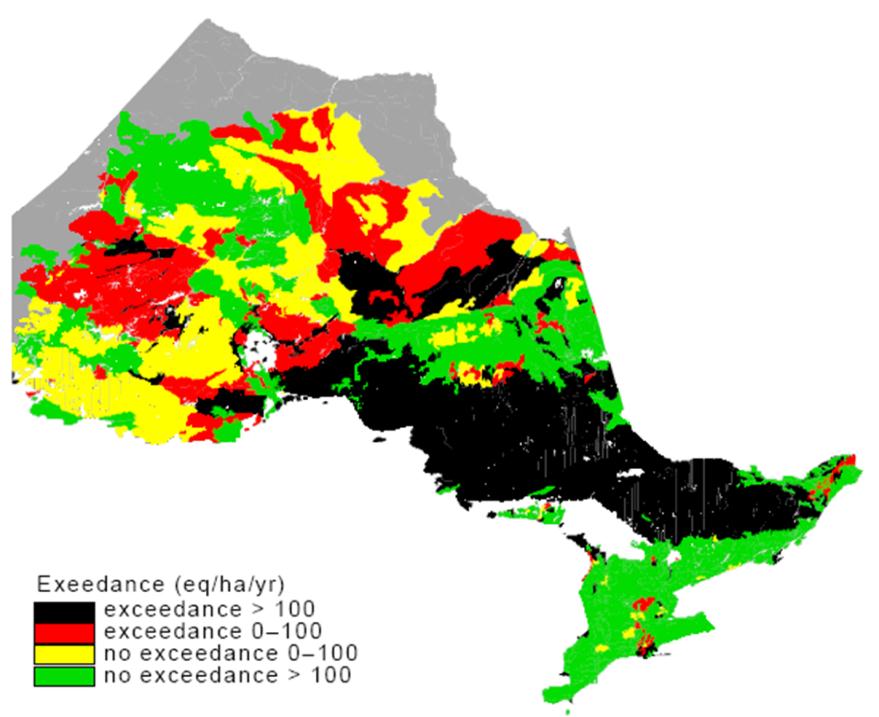Human activities caused emissions of sulphur and nitrogen to increase dramatically in the middle of the twentieth century (Driscoll et al. 2001). Control programs have reduced emissions but sulphur and nitrogen compounds are expected to have continuing negative impacts on biodiversity. In particular, sulphur and nitrogen compounds in the form of acid rain can cause acidification of soils and surface waters and can decrease soil nutrients to inadequate levels for plant growth. In addition, excess nitrogen deposition can lead to nitrogen saturation (Aber et al. 1989, 1998). Having too much nitrogen can result not only in elevated nitrate leaching and further stream and soil acidification, but may also lead to plant nutrient imbalances.
In recent years, critical loads have been used as an effects-based tool to assess the sensitivity of terrestrial and freshwater ecosystems to the effects of sulphur and nitrogen deposition. By comparing the critical loads with atmospheric deposition (e.g. from rainfall or airborne particles), and determining the excess deposition above the critical load (i.e., the “exceedance”), the potential impacts of current and future deposition scenarios can be examined. This information can be used to help guide policies that define the emission abatements required to protect sensitive ecosystems. Critical load models have been an important and successful tool for the development of control strategies for transboundary air pollution in Europe (Grennfelt et al. 2001), and have been integrated into the Canada-Wide Acid Rain Strategy for Post-2000.
Critical loads for nitrogen and sulphur have been calculated with a limited set of soil chemistry data for forest soils in Ontario (Watmough et al. 2004) (Figure 1). The results of this work indicate that approximately 40 million hectares of forest in Ontario continue to receive acid deposition from nitrogen and sulphur in amounts above the critical load. Of this area, the critical load is exceeded by more than 100 eq ha–1 yr–1 for approximately 25 million hectares. The majority of these areas occur in the Ontario Shield, where mineral soils with low weathering parent materials and organic soils make it vulnerable. Results from more than 20 years of catchment studies in central Ontario indicate that soils continue to acidify despite reductions in sulphur and nitrogen deposition and that soil losses of calcium, an essential nutrient for tree growth and health, are of particular concern (Watmough et al. 2003; 2004). Trees in nutrient-depleted areas will become increasingly susceptible to natural stresses and forest productivity will likely decline in these regions.

Figure 1. Exceedance of critical loads of acidity (nitrogen and sulphur) for forest soils in Ontario (note: grey colour refers to areas with no data). (Source: Watmough et al. 2004).
Figure 1. Exceedance of critical loads of acidity (nitrogen and sulphur) for forest soils in Ontario (note: grey colour refers to areas with no data). (Source: Watmough et al. 2004).
References:
Aber, J.D., W.H. McDowell, K.J. Nadelhoffer, A. Magill, G. Berntson, M. Kamakea, S.G. McNulty, W. Currie, L. Rustad, and I. Fernandez. 1998. Nitrogen saturation in temperate forest ecosystems: hypotheses revisited. BioScience 48:921-934.
Aber, J.D., K.J. Nadelhoffer, P. Steudler, and J.M. Melillo. 1989. Nitrogen saturation in northern forest ecosystems. BioScience 39: 378-386.
Driscoll, C.T., G.B. Lawrence, A.J. Bulger, T.J. Butler, C.S. Cronan, C. Eagar, K.F. Lambert, G.E. Likens, J.L. Stoddard, and K.C. Weathers. 2001. Acidic deposition in the northeastern United States: sources and inputs, ecosystem effects, and management strategies. BioScience 51:180-198.
Grennfelt, P., F. Moldan, M. Alveteg, P. Warfvinge, and H. Sverdrup. 2001. Critical loads – is there a need for a new concept? Water, Air, Soil Pollution: Focus 1:21–27.
Watmough, S.A., J. Aherne, and P.J. Dillon, 2003. Calculating critical loads of acid deposition for forests in Ontario using the NEG-ECP Working Group Protocol on critical loads. Final Report, November 2003. Trent University, Peterborough, ON.
Watmough, S.A., J. Aherne, and P.J. Dillon. 2004. Relating exceedance of critical load with biological effects at Ontario forests. Final Report, March 2004. Trent University, Peterborough, ON.
